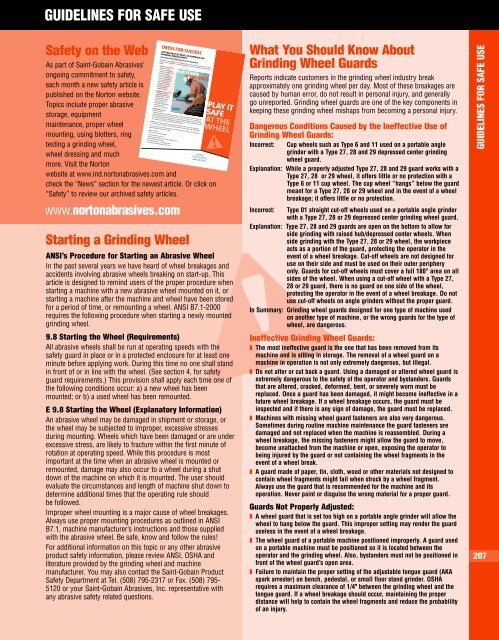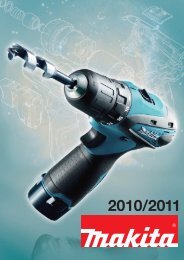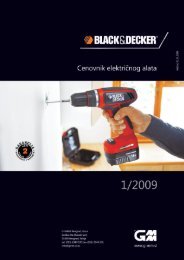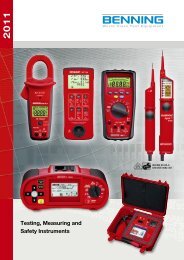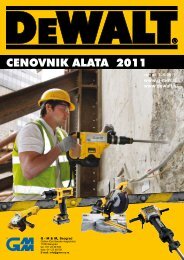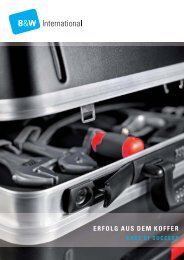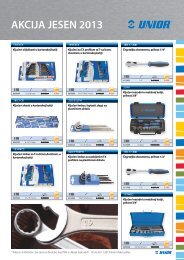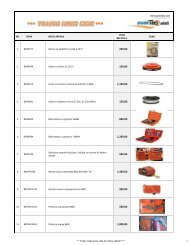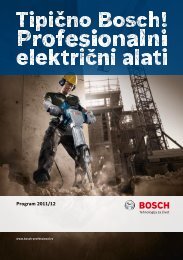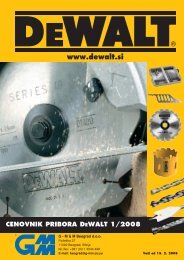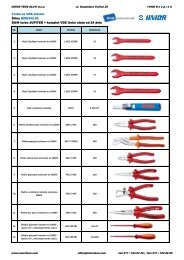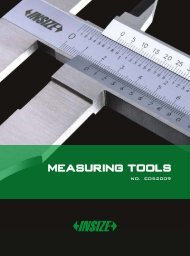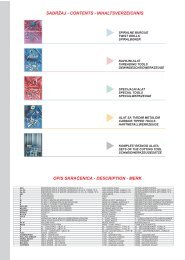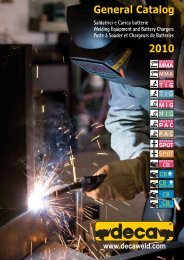Cut-off Wheels
Cut-off Wheels
Cut-off Wheels
Create successful ePaper yourself
Turn your PDF publications into a flip-book with our unique Google optimized e-Paper software.
®<br />
4<br />
3<br />
2<br />
1<br />
#7868<br />
© Saint-Gobain Abrasives, Inc. June 2 04<br />
GUIDELINES FOR SAFE USE<br />
Safety on the Web<br />
As part of Saint-Gobain Abrasives’<br />
ongoing commitment to safety,<br />
each month a new safety article is<br />
published on the Norton website.<br />
Topics include proper abrasive<br />
storage, equipment<br />
maintenance, proper wheel<br />
mounting, using blotters, ring<br />
testing a grinding wheel,<br />
wheel dressing and much<br />
more. Visit the Norton<br />
website at www.ind.nortonabrasives.com and<br />
check the “News” section for the newest article. Or click on<br />
“Safety” to review our archived safety articles.<br />
www.nortonabrasives.com<br />
DRESS FOR SUCCESS<br />
GETTING BACK TO BASICS IN PORTABLE CUP<br />
GRINDING WHEEL SAFETY!<br />
Safety begins with PPE (Personal Protective Equipment).<br />
Attached is a photograph i lustrating an operator wearing the required PPE. Get back<br />
to basics and review the four simple,butimportant rules for portable angle grinding<br />
safety.<br />
1. SPEED: Make sure the<br />
abrasive wheel’s<br />
maximum operating<br />
speed is at or above the<br />
portable grinder’s<br />
maximum operating<br />
speed. Exceeding the<br />
maximum operating<br />
speed of an abrasive<br />
wheel is extremely<br />
dangerous. Excessive<br />
speed can cause an<br />
abrasive wheel to<br />
suddenly shatter!<br />
2. GUARDS: Use the correct<br />
wheel guard for the<br />
portable machine and<br />
abrasive wheel. Prior to<br />
using,properly adjust<br />
the wheel guard. Al<br />
abrasive wheels are<br />
breakable and grinding<br />
wheel guards can<br />
preventserious injuries.<br />
3. MOUNTING: Employ<br />
only the proper<br />
mounting system for the abrasive wheel used. Test any newly mounted wheel by<br />
operating that wheel in an enclosed area (i.e.under work bench or in steel drum)<br />
for one fu l minute before attempting to use the abrasive wheel. Make certain that<br />
the machine and abrasive wheels are compatible. Never mount an abrasive wheel<br />
on a machine NOT designed for thatabrasive wheel.<br />
4.PPE: Wear a l required personal protective equipmentsuch as eye,face, hearing,<br />
and respiratory protection;as well as gloves, aprons,arm guards and safety shoes.<br />
To access this poster in PDF format, from our website click on Library, select Safety,and<br />
download Safety Poster Norton.pdf<br />
Roger E.Cloutier<br />
Senior Product Safety Engineer<br />
Saint-Gobain Abrasives, Inc.<br />
PO Box 15008 - M/S 413-201, One New Bond Street<br />
Worcester,MA 01615-0008<br />
Tel. (508) 795-2690 • Fax (508) 795-5120<br />
Email: NortonSafety@saint-gobain.com<br />
Starting a Grinding Wheel<br />
PLAY IT SAFE<br />
AT THE WHEEL<br />
1 Sp ed: Make sure wh el is<br />
rated at or above the grinder's rating.<br />
2 Guard: Use the right guard and never grind<br />
withou the guard on the grinder.<br />
3 Mounting: Inspec the wh el before mounting and run<br />
a test in an enclosed area prior to grinding. Only use<br />
grinders with a proper back flange.<br />
4 Wear a l required personal protective equipment such as eye,<br />
face, hearing, and respiratory protection; as we l as gloves,<br />
aprons, arm guards, and safety shoes.<br />
For a ditional information on this topic or any other grinding wh el safety information, please review<br />
ANSI, OSHA and literature provided by the grinding wh el and machine manufacturer. You may also contact<br />
the Saint-Gobain Product Safety Department a telephone (508) 795-2317 or fax (508) 795-5120 or contact<br />
your Stone Bo s representative with any safety-related questions.<br />
PLAY IT<br />
SAFE<br />
AT THE<br />
WHEEL<br />
ANSI’s Procedure for Starting an Abrasive Wheel<br />
In the past several years we have heard of wheel breakages and<br />
accidents involving abrasive wheels breaking on start-up. This<br />
article is designed to remind users of the proper procedure when<br />
starting a machine with a new abrasive wheel mounted on it, or<br />
starting a machine after the machine and wheel have been stored<br />
for a period of time, or remounting a wheel. ANSI B7.1-2000<br />
requires the following procedure when starting a newly mounted<br />
grinding wheel.<br />
9.8 Starting the Wheel (Requirements)<br />
All abrasive wheels shall be run at operating speeds with the<br />
safety guard in place or in a protected enclosure for at least one<br />
minute before applying work. During this time no one shall stand<br />
in front of or in line with the wheel. (See section 4, for safety<br />
guard requirements.) This provision shall apply each time one of<br />
the following conditions occur: a) a new wheel has been<br />
mounted; or b) a used wheel has been remounted.<br />
E 9.8 Starting the Wheel (Explanatory Information)<br />
An abrasive wheel may be damaged in shipment or storage, or<br />
the wheel may be subjected to improper, excessive stresses<br />
during mounting. <strong>Wheels</strong> which have been damaged or are under<br />
excessive stress, are likely to fracture within the first minute of<br />
rotation at operating speed. While this procedure is most<br />
important at the time when an abrasive wheel is mounted or<br />
remounted, damage may also occur to a wheel during a shut<br />
down of the machine on which it is mounted. The user should<br />
evaluate the circumstances and length of machine shut down to<br />
determine additional times that the operating rule should<br />
be followed.<br />
Improper wheel mounting is a major cause of wheel breakages.<br />
Always use proper mounting procedures as outlined in ANSI<br />
B7.1, machine manufacturer’s instructions and those supplied<br />
with the abrasive wheel. Be safe, know and follow the rules!<br />
For additional information on this topic or any other abrasive<br />
product safety information, please review ANSI, OSHA and<br />
literature provided by the grinding wheel and machine<br />
manufacturer. You may also contact the Saint-Gobain Product<br />
Safety Department at Tel. (508) 795-2317 or Fax. (508) 795-<br />
5120 or your Saint-Gobain Abrasives, Inc. representative with<br />
any abrasive safety related questions.<br />
What You Should Know About<br />
Grinding Wheel Guards<br />
Reports indicate customers in the grinding wheel industry break<br />
approximately one grinding wheel per day. Most of these breakages are<br />
caused by human error, do not result in personal injury, and generally<br />
go unreported. Grinding wheel guards are one of the key components in<br />
keeping these grinding wheel mishaps from becoming a personal injury.<br />
Dangerous Conditions Caused by the Ineffective Use of<br />
Grinding Wheel Guards:<br />
Incorrect: Cup wheels such as Type 6 and 11 used on a portable angle<br />
grinder with a Type 27, 28 and 29 depressed center grinding<br />
wheel guard.<br />
Explanation: While a properly adjusted Type 27, 28 and 29 guard works with a<br />
Type 27, 28 or 29 wheel, it <strong>off</strong>ers little or no protection with a<br />
Type 6 or 11 cup wheel. The cup wheel “hangs” below the guard<br />
meant for a Type 27, 28 or 29 wheel and in the event of a wheel<br />
breakage; it <strong>off</strong>ers little or no protection.<br />
Incorrect: Type 01 straight cut-<strong>off</strong> wheels used on a portable angle grinder<br />
with a Type 27, 28 or 29 depressed center grinding wheel guard.<br />
Explanation: Type 27, 28 and 29 guards are open on the bottom to allow for<br />
side grinding with raised hub/depressed center wheels. When<br />
side grinding with the Type 27, 28 or 29 wheel, the workpiece<br />
acts as a portion of the guard, protecting the operator in the<br />
event of a wheel breakage. <strong>Cut</strong>-<strong>off</strong> wheels are not designed for<br />
use on their side and must be used on their outer periphery<br />
only. Guards for cut-<strong>off</strong> wheels must cover a full 180° area on all<br />
sides of the wheel. When using a cut-<strong>off</strong> wheel with a Type 27,<br />
28 or 29 guard, there is no guard on one side of the wheel,<br />
protecting the operator in the event of a wheel breakage. Do not<br />
use cut-<strong>off</strong> wheels on angle grinders without the proper guard.<br />
In Summary: Grinding wheel guards designed for one type of machine used<br />
on another type of machine, or the wrong guards for the type of<br />
wheel, are dangerous.<br />
Ineffective Grinding Wheel Guards:<br />
❚ The most ineffective guard is the one that has been removed from its<br />
machine and is sitting in storage. The removal of a wheel guard on a<br />
machine in operation is not only extremely dangerous, but illegal.<br />
❚ Do not alter or cut back a guard. Using a damaged or altered wheel guard is<br />
extremely dangerous to the safety of the operator and bystanders. Guards<br />
that are altered, cracked, deformed, bent, or severely worn must be<br />
replaced. Once a guard has been damaged, it might become ineffective in a<br />
future wheel breakage. If a wheel breakage occurs, the guard must be<br />
inspected and if there is any sign of damage, the guard must be replaced.<br />
❚ Machines with missing wheel guard fasteners are also very dangerous.<br />
Sometimes during routine machine maintenance the guard fasteners are<br />
damaged and not replaced when the machine is reassembled. During a<br />
wheel breakage, the missing fasteners might allow the guard to move,<br />
become unattached from the machine or open, exposing the operator to<br />
being injured by the guard or not containing the wheel fragments in the<br />
event of a wheel break.<br />
❚ A guard made of paper, tin, cloth, wood or other materials not designed to<br />
contain wheel fragments might fail when struck by a wheel fragment.<br />
Always use the guard that is recommended for the machine and its<br />
operation. Never paint or disguise the wrong material for a proper guard.<br />
Guards Not Properly Adjusted:<br />
❚ A wheel guard that is set too high on a portable angle grinder will allow the<br />
wheel to hang below the guard. This improper setting may render the guard<br />
useless in the event of a wheel breakage.<br />
❚ The wheel guard of a portable machine positioned improperly. A guard used<br />
on a portable machine must be positioned so it is located between the<br />
operator and the grinding wheel. Also, bystanders must not be positioned in<br />
front of the wheel guard’s open area.<br />
❚ Failure to maintain the proper setting of the adjustable tongue guard (AKA<br />
spark arrester) on bench, pedestal, or small floor stand grinder. OSHA<br />
requires a maximum clearance of 1/4" between the grinding wheel and the<br />
tongue guard. If a wheel breakage should occur, maintaining the proper<br />
distance will help to contain the wheel fragments and reduce the probability<br />
of an injury.<br />
GUIDELINES FOR SAFE USE<br />
207


